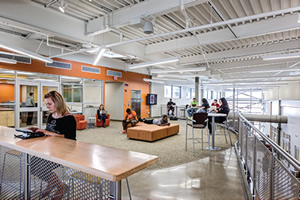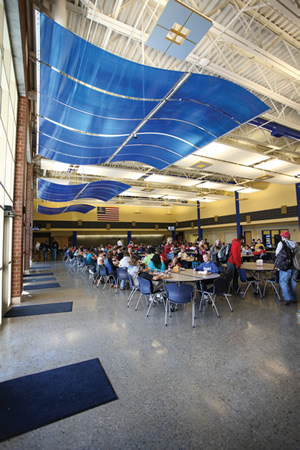Figuring Life Cycle Costs
- By Michael Fickes
- 10/01/15

Milan Center for Innovative Studies: Furniture and soft seating, especially in high-use areas, must be durable enough to provide an attractive, welcoming environment for many years. Photo courtesy of Fanning Howey. Justin Maconochie Photography.
WHAT KIND OF LIGHTING SYSTEM SHOULD YOU BUY FOR YOUR NEXT ELEMENTARY SCHOOL BUILDING? HOW DID YOU MAKE THE DECISION?
By and large, today’s lighting choices include fluorescent and light emitting diode (LED). Choosing between the two requires an exercise in lifecycle cost estimating — figuring out which lighting system will cost less to buy, install and operate over the, say, 50-year life of the school building.
Fluorescent lighting certainly wins the first cost competition. Fluorescent lighting costs about 30 percent to 40 percent less than LED to acquire — a dramatically lower first cost.
Then again, LED lighting costs 30 percent to 50 percent less to operate.
“It is possible for an elementary school to see a difference of nearly a million dollars over the course of 30 to 40 years with LED lighting compared to fluorescent lighting,” says Terry Liette, principal and chief engineering officer with Fanning Howey, an architectural firm specializing in the educational field.
Purchasing lighting, mechanical systems, copiers, computers, flooring and furniture for a school system requires different kinds of analyses. In some cases, lifetime cost analysis works. In other cases, it is more important to determine an appropriate replacement schedule. Here’s a look at how purchasing people think about these problems.
MECHANICAL SYSTEMS
Liette uses an approach similar to the lighting analysis noted above to think about the various components of mechanical systems.
For a new elementary school on the grounds of the West Point Military Academy, he looked at a 40-year lifecycle for the chiller plant. “We evaluated an aircooled chiller plant with a high efficiency condensing water boiler plant using variable volume re-heat,” he says. “We found that such a system would produce a 40-year life cycle cost that was $300,000 less than a comparable system using an indoor water cooled chiller plant with the same condensing boiler plant and the same variable volume re-heat air system.
“These are air handling units installed with variable volume re-heat terminals at each classroom.
“Armed with this information, the owner made the decision to go with the more expensive installation in a bid to save costs over the 40-year lifecycle.”
COMPUTERS
Students, teachers and administrators today use desktop computers, laptops and tablets throughout the day.
“With computing equipment, we look at a replacement period of three years,” says Jeff Kimball, director of cooperative purchasing services with the Central Susquehanna Intermediate Unit, based in Lewisburg, Pa. “Our technical people tell us that when you buy a computer and take delivery, a newer, faster and better processor is already on the market. They recommend that we replace computer equipment every three years — to keep up with the changing technology.”
Kimball goes on to say that failing to keep up with new technology means that software programs will run more slowly, while some may not work at all with the older technology. “That’s especially true if you are using publishing software, manipulating photos and editing video — carrying out processor-intensive tasks.”
What about Wi-Fi? The equipment is typically Wi-Fi enabled and students can use the Internet for research while in school. For homework, Kimball says that students who don’t have Wi-Fi connections at home can use public libraries, which typically provide free Wi-Fi connections.
LEASING AND BUYING PHOTOCOPIERS
Photocopying equipment poses a different set of challenges. Kimball buys mid-size and large copying machines for his schools.
“More and more schools are leasing photocopiers,” Kimball says. “They lease the equipment for three to five years. At the end of the lease term, they turn the equipment in and get new equipment on another lease.”
Pricing photocopying leases involves estimating the number of copies per month per machine plus toner and maintenance. “You come up with a figure for that and compare what you would spend on a lease with the purchase price,” continues Kimball.
Some schools purchase the equipment at the end of the lease term, notes Kimball. Those that buy copiers must also pay for parts and service.
Be careful, though. Kimball says that parts can be hard to find after seven years. “We’ve seen schools get away with it for as many as eight or nine years,” he says. “Eventually, however, manufacturers will stop supporting older machines, and you won’t be able to find parts. So we recommend a four or five year replacement schedule.
“Consumables such as photocopying paper, staples and paper clips don’t figure into these calculations. These items are just bought outright.”

St. Marys Middle/High School: Polished concrete floors are a good alternative to traditional VCT, due to their lower cost of maintenance. Photo courtesy of Fanning Howey.
FLOORING: OUT WITH VCT
Ten to 15 years ago, many schools used vinyl composition tile (VCT) flooring, says Stephanie Barnett, NCIDQ, LEED-AP, an interior designer and associate in Fanning Howey’s Indianapolis office.
“VCT has a low initial cost of $1.50 to $1.75 per square foot,” says Barnett. “But it also requires a lot of labor. You have to put on five coats of wax after first laying it down. Then you have to strip it and re-wax at least two or three times a year. That takes a lot of hours and requires equipment to strip, re-wax and buff.”
Today, there are affordable, lowermaintenance alternatives to VCT. These include polished concrete and rubber flooring, which can be maintained with a wet mop and vacuum cleaner and have longer warranties.
“You also have to buff these floors initially, but the process isn’t as time consuming as it is with VCT flooring,” says Barnett.
FURNITURE: BUYING DURABILITY
Barnett recommends durable commercial grade furniture for schools. “You can buy an office chair for your home office for about $100 at a big-box store,” she says. “But prices for commercial rated furniture are much higher. Office chairs for administrators might cost $400, but that will include a 10-year warranty.”
Barnett also specifies fabrics for seating. She asks for crypton fabrics, a built-in fabric technology that repels stains. Spilled liquids simply bead up and can be wiped away.
“Another fabric specification for us is called double rubs,” Barnett says. “This tests for wear-ability. Manufacturers rub back and forth over a fabric, making a double rub. They do this until the fabric fails. We specify fabrics rated with 70,000 double rubs or more.”
When it comes to classroom furniture, experts recommend looking first for durability. “Good furniture can last for 20 years,” says Gary Slocum, a client liaison with Fanning Howey’s Dublin, Ohio office. “With limited time and resources, we don’t have the ability to conduct our own life-cycle analysis for items like furniture. Instead, we relay on our designers, vendors and peer groups.
“With any project, there is always a tension between quality and budget. When we do need to get creative with solutions, we try to do so without sacrificing quality. For instance, I would spread a furniture replacement project over two years, drawing from two different annual budgets before I would buy a lowerquality product to get everything done at once. Quality almost always pays for itself in the long run.”
In the end, the key to wise purchasing is quality. Whether you are buying mechanical systems, lighting, flooring, copiers, computers or furniture, look for the highest quality your budget can afford.
To Bid Or Not To Bid
School districts must follow state legal requirements when making purchases. Districts can add their own requirements on top of the state requirements as long as they are stricter than those of the state.
For example, Rochester Public Schools in Minnesota has established three general guidelines to govern purchasing.
First, the purchasing manager must solicit at least three sealed bids for any purchase estimated to exceed $100,000. The solicitation must be in the form of a public notice and subject to contact law.
Second, for purchases between $10,000 and $100,000, the department must prepare a Request for Quote and obtain at least three quotes.
Third, RFQs must be filed at the District Purchasing Office and retained for one year.
This article originally appeared in the issue of .